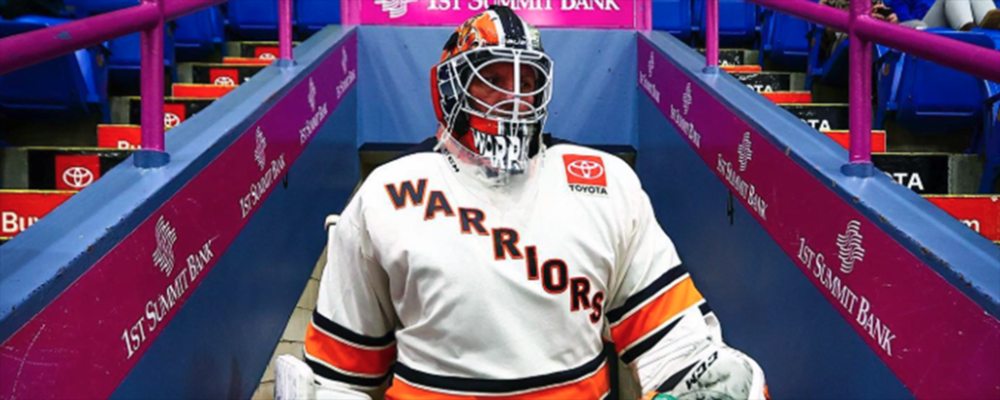Warrior Hockey Continuing to Grow Throughout the U.S.

In a little over two years, Brandon Beaver has seen the discipline of Warrior Hockey grow rapidly.
“It’s just kind of exploded,” said Beaver, USA Hockey’s manager of disabled hockey. “When I came into this position in 2022, we were right around 15 organizations that were fully functioning, and now we're over 60 organizations. It's definitely growing.”
The 2025 USA Hockey Warrior National Championships will feature increases in participation, performance and presence when 50 teams in the rapidly growing sport take to the ice in Coral Springs, Florida, on April (24-27).
The inaugural event held last year in New Jersey featured 34 teams divided by competition level in six tiers.
“What we've done this year, based on our ice time availability, we've capped it at 50 teams, just for this event,” said Beaver, a 15-year U.S. Army veteran and Wounded Warrior alumnus. “But Warrior as a whole has grown tremendously within the last two years.”
Bill Duffy, a 50-year-old retired Air Force veteran and president of the Flyers Warrior organization in Philadelphia, has witnessed the growth at the local level, both as an administrator and as a goalie.
Duffy first began playing for the Flyers only a couple months after the team was founded. When he first joined, there were around 33 players in the organization. Now, there’s 140.
“It’s just the bond with the guys that I’ve become friends with,” he said. “When we started this program, almost six years ago, we didn’t know each other from Adam. Now we’re together every week off the ice as much as on the ice.”
To be eligible for Warrior Hockey, a player must have an honorable discharge from at least one of the six branches of service — Army, Air Force, Navy, Marine Corps, Coast Guard, Space Force, including reserve and National Guard components.
Players also must have a minimum of 10% service-connected disability rating from the Department of Veterans Affairs, or have been awarded a Purple Heart Medal, regardless of their VA disability rating.
“Coming off wars, for example let’s use Iraq and Afghanistan, and you take the 10-year period following that, you have a lot of injured veterans and a lot of disabled veterans who come out of those circumstances,” Beaver said,“and they’re looking for outlets and we happen to be one of those outlets. A large number of our new participants are first-time hockey players.”
Duffy, who grew up playing hockey and then continued during his various military deployments, said he relishes the camaraderie as well as the competition.
“I still enjoy playing at a very high competitive level and I’m glad I’m still able to do it,” he said. “I was fortunate enough to grow up around the Philadelphia Flyers training facility in the ‘80s and ‘90s. Then I joined the Air Force and kept playing competitive overseas. I never stopped playing even though I was stationed all over the world. I always found a way to still keepplaying.”
As with other levels of hockey, women’s participation has grown substantially and quickly in Warrior, Beaver said.
Beaver added that most of the women who pick up Warrior hockey don’t want to play on gender-specific teams. He offered to create a women’s division, but the men and women who play regularly agreed they’d rather share the ice together.
The level of play also continues to improve, said Beaver, who grew up playing hockey in Pennsylvania.
“A lot of the elite teams across the country, they don't have many other organizations to play and they're a lot higher level than other league teams,” Beaver said. “So, they've begun playing the Division III schools and the college Division I club teams, and they actually give them a run for their money.”
Many of the elite-level players played collegiately, including the service academy intercollegiate programs.
The national championships and other tournaments also have a significant economic impact on the host area.
Many teams travel with two to five coaches, and some of the teams in higher divisions travel with athletic trainers, team doctors or equipment managers, Beaver said. That doesn’t even account for everyone who comes just to watch the games.
“Almost every player travels with a wife, a mother, a father, kids, or if they grew up playing in that area, all of their family and all their friends come out,” he said. “And the stands are packed so the economic impact is huge for these cities.”
The growth of disabled hockey, including the Warrior program, has made Beaver’s job easier and more demanding at the same time.
“My main job is to grow six disabled disciplines, with Warrior being our fastest-growing one,” he said. “It makes my job easier because I don’t have to search to grow it, it grows on its own. It’s organic. But keeping up with it is a difficulty.”
But as Beaver pointed out, it’s a good problem to have.
Story from Red Line Editorial, Inc.
Source: usahockey.com
